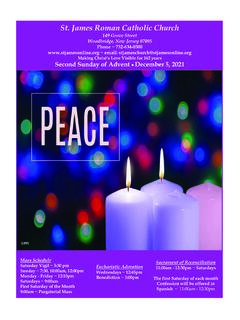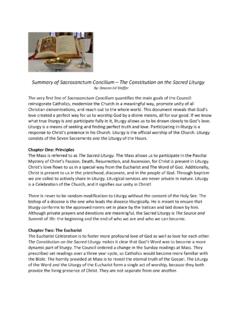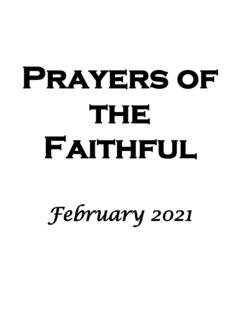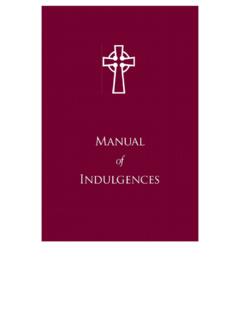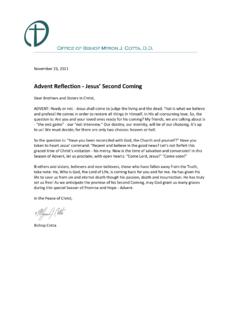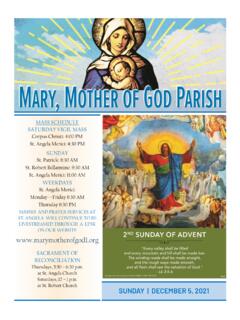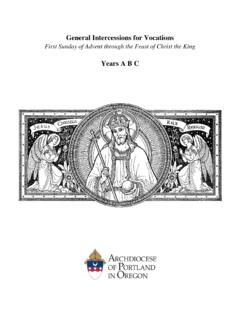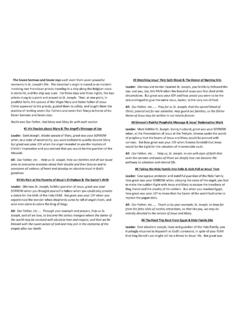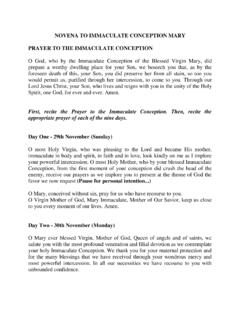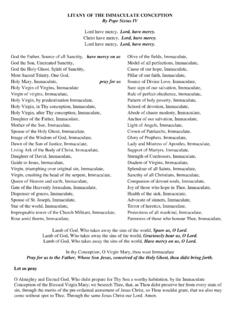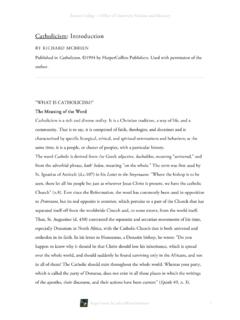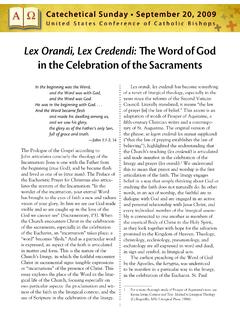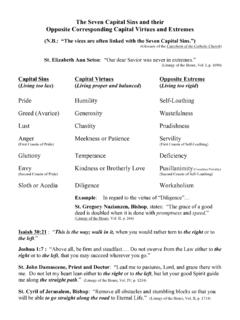Transcription of The APOSTLES' CREED
1 1 The APOSTLES' CREED I believe in God, the Father almighty, Creator of heaven and earth, and in Jesus Christ, His only Son, our Lord, who was conceived by the Holy Spirit, born of the Virgin Mary, suffered under Pontius Pilate, was crucified, died and was buried; He descended into hell; on the third day He rose again from the dead; He ascended into heaven, and is seated at the right hand of God the Father almighty; from there He will come to judge the living and the dead. I believe in the Holy Spirit, the holy Catholic church , the communion of saints, the forgiveness of sins, the resurrection of the body, and life everlasting. Amen. 2 CATECHISM OF THE CATHOLIC church - SECOND EDITION PART ONE- THE PROFESSION OF FAITH SECTION TWO- THE PROFESSION OF THE CHRISTIAN FAITH online?
2 Click Vatican Link to the CCC, paragraphs 185- 197 THE CREEDS 185 Whoever says "I believe" says "I pledge myself to what we believe." Communion in faith needs a common language of faith, normative for all and uniting all in the same confession of faith. 186 From the beginning, the apostolic church expressed and handed on her faith in brief formula nor-mative for But already very early on, the church also wanted to gather the essential elements of her faith into organic and articulated summaries, intended especially for candidates for Baptism: This synthesis of faith was not made to accord with human opinions, but rather what was of the greatest importance was gathered from all the Scriptures, to present the one teaching of the faith in its entirety.
3 And just as the mustard seed contains a great number of branches in a tiny grain, so too this summary of faith encompassed in a few words the whole knowledge of the true religion contained in the Old and the New 187 Such syntheses are called "professions of faith" since they summarize the faith that Christians pro-fess. They are called "creeds" on account of what is usually their first word in Latin: credo ("I believe"). They are also called "symbols of faith." 188 The Greek word symbolon meant half of a broken object, for example, a seal presented as a token of recognition. The broken parts were placed together to verify the bearer's identity. The symbol of faith, then, is a sign of recognition and communion between believers.
4 Symbolon also means a gather-ing, collection or summary. A symbol of faith is a summary of the principal truths of the faith and there-fore serves as the first and fundamental point of reference for catechesis. 189 The first "profession of faith" is made during Baptism. The symbol of faith is first and foremost the baptismal CREED . Since Baptism is given "in the name of the Father and of the Son and of the Holy Spirit",3 the truths of faith professed during Baptism are articulated in terms of their reference to the three persons of the Holy Trinity. 190 And so the CREED is divided into three parts: "the first part speaks of the first divine Person and the wonderful work of creation; the next speaks of the second divine Person and the mystery of his re-demption of men; the final part speaks of the third divine Person, the origin and source of our sanctifi-cation.
5 "4 These are "the three chapters of our [baptismal] seal".5 191 "These three parts are distinct although connected with one another. According to a comparison often used by the Fathers, we call them articles. Indeed, just as in our bodily members there are cer-tain articulations which distinguish and separate them, so too in this profession of faith, the name arti-cles has justly and rightly been given to the truths we must believe particularly and distinctly."6 3 In accordance with an ancient tradition, already attested to by St. Ambrose, it is also customary to reckon the articles of the CREED as twelve, thus symbolizing the fullness of the apostolic faith by the number of the 192 Through the centuries many professions or symbols of faith have been articulated in response to the needs of the different eras: the creeds of the different apostolic and ancient Churches,8 , the Quicumque, also called the Athanasian CREED ;9 the professions of faith of certain Councils, such as Toledo, Lateran, Lyons, Trent.
6 10 or the symbols of certain popes, , the Fides Damasi11 or the Credo of the People of God of Paul 193 None of the creeds from the different stages in the church 's life can be considered superseded or irrelevant. They help us today to attain and deepen the faith of all times by means of the different sum-maries made of it. Among all the creeds, two occupy a special place in the church 's life: 194 The Apostles' CREED is so called because it is rightly considered to be a faithful summary of the apostles' faith. It is the ancient baptismal symbol of the church of Rome. Its great authority arises from this fact: it is "the CREED of the Roman church , the See of Peter the first of the apostles, to which he brought the common faith".
7 13 195 The Niceno-Constantinopolitan or Nicene CREED draws its great authority from the fact that it stems from the first two ecumenical Councils (in 325 and 381). It remains common to all the great Churches of both East and West to this day. 196 Our presentation of the faith will follow the Apostles' CREED , which constitutes, as it were, "the old-est Roman catechism". The presentation will be completed however by constant references to the Ni-cene CREED , which is often more explicit and more detailed. 197 As on the day of our Baptism, when our whole life was entrusted to the "standard of teaching",14 let us embrace the CREED of our life-giving faith. To say the Credo with faith is to enter into communion with God, Father, Son and Holy Spirit, and also with the whole church which transmits the faith to us and in whose midst we believe: This CREED is the spiritual seal, our heart's meditation and an ever-present guardian; it is, unquestionably, the treasure of our 9 Cf.
8 DS 75-76. 10 Cf. DS 525-541; 800-802; 851-861; 1862-1870. 11 Cf. DS 71-72. 12 Paul VI, CPG (1968). 13 St. Ambrose, Expl. symb. 7: PL 17,1196. 14 Rom 6:17. 15 St. Ambrose, Expl. symb. 1:PL 17,1193. 1 Cf. Rom 10:9; 1 Cor 15:3-5,etc. 2 St. cyril of jerusalem , Catech. illum. 5,12: PG 33,521-524. 3 Mt 28:19. 4 Roman Catechism I,1,3. 5 St. Irenaeus, Dem. ap. 100: SCh 62,170. 6 Roman Catechism I,1,4. 7 Cf. St. Ambrose, Expl. symb. 8. REFERENCES 4 FROM OUR SISTERS AND BROTHERS IN THE DIOCESE OF COVINGTON, KENTUCKY The church always believes as she prays. From the time of the apostles until the current age, the way the church prays effects what she believes. Her prayer is most completely revealed within the liturgical life the celebration of the Sacraments and other ritualistic actions.
9 In the second century, the church of Rome was using a baptismal formula, which had the catechumens (those to be baptized) declare their belief in the Triune God as well as the church and the resurrection of the body via a series of questions. These questions, which find similarity to the baptismal rites of today, developed into the Apostles CREED by the end of the seventh century. As the Christian s CREED or statement of belief began to develop, there were questions as to its real ne-cessity. The church was understood in her early history, as we believe today, to be a living and vibrant organism. And so, just as She grew in age and wisdom, so too it was argued, should the way in which She expresses what She believes.
10 But as She grew in wisdom She learned that if She relied only on oral traditions, the authentic apostolic faith could become distorted. Anyone who has ever played the game Telephone understands that the farther away you get from the source the more likely the message is going to get garbled. In addition, by writing down Her faith and putting it into a creedal statement, it allowed Her to more accurately declare that which She believed and assisted Her in confronting heresies which threatened to do Her harm. The 3rd Edition of the Roman Missal calls for the Apostles CREED to be used more regularly in the church s liturgical life. No longer will the Apostles CREED find itself reserved for use in Masses with chil-dren and for the praying of the Most Holy Rosary.
